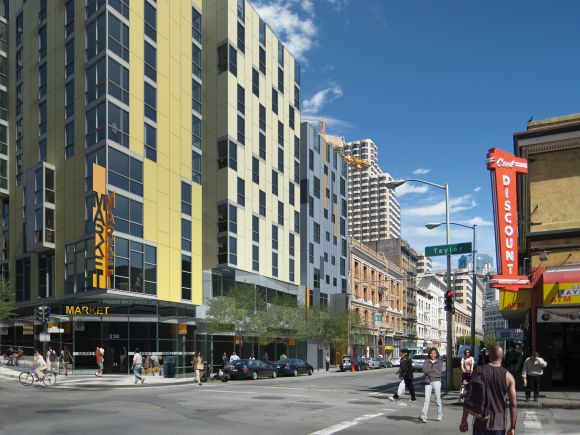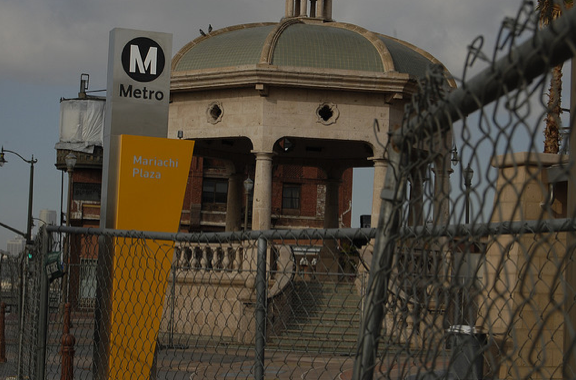Streetsblog San Francisco reported earlier this week that the Metropolitan Transportation Commission has made a $10 million funding commitment to a mixed-use affordable housing project in the Tenderloin neighborhood, a convenient two-block walk from the nearest Muni stop:
The development at 168 Eddy Street would provide 153 new apartments reserved for low-income families and space for a 12,000-foot street-level grocery store. It would help quell some of the high demand for affordable housing in the neighborhood, where valuable lots used to park cars diminish the urban fabric despite very low car ownership. Bringing the first full-sized grocery market to the neighborhood would also provide access to healthy food options within walkable distances.
But as Gen Fujioka wrote this week on Streetsblog Los Angeles, San Francisco hasn't always had policies in place to preserve space for low-income people as property values near transit skyrocketed.
One test of San Francisco’s affordable housing policies came in the 1990s during the dot-com boom. Amidst a hot real estate market, development pressures grew particularly in transit-rich areas. Evictions reached record levels and entire neighborhoods were transformed in a few years. According to research by UC Berkeley’s Center on Community Innovation, during the period between 1995 and 2000, the out-migration of low-income households exceeded 9,800 each year while the numbers of upper income households grew. Proximity to transit was a significant factor in explaining the pattern of displacement. Neighborhoods within a half-mile of major transit were particularly at risk of gentrification and displacement, suffering marked declines in the number of households of color.
Local social justice groups mobilized and got the city to adopt a moratorium on new development. Stagnant residential construction can also lead to rising rents, so more and more, planners are looking for ways to ensure that transit-oriented development goes hand in hand with housing affordability. Initiatives like the one now underway in the Tenderloin are a welcome sign that localities are waking up to the unintended consequences of TOD -- that the rising tides of property values may not lift all boats.
Many cities are still struggling to get it right. In Seattle's multi-ethnic, low-income International District (also known as the "ID"), now the central nexus of the region’s transit, the city adopted "a transit-oriented upzoning" to allow more than a doubling of housing units in the already high-density district. Fujioka writes:
On paper, the plan’s goals would create 4,500 units of housing affordable for lower income households; however, the new zoning does not ensure the affordable units will ever be built. Over the next six years the city’s estimated $145 million housing fund will support the production of 1,800 affordable units for the entire city. If the ID received a proportionate share of the projected funding, it would only support several hundred new affordable units. “So far, smart growth in Seattle doesn’t add up,” says Ken Katahira, housing development staff for InterIm Community Development Association, a nonprofit that has built affordable housing and a community garden in the neighborhood. “Zoning for higher densities does not necessarily create more affordable housing.”
Los Angeles, still in the early phases of rebuilding its transit system, is finding its way when it comes to ensuring that the benefits of transit-oriented development are distributed equitably. Community groups in the predominantly Latino Boyle Heights neighborhood, where one of the first rail lines is being built, are now fighting to claim space for people of color in the coming wave of development. “After they started construction we had a wave of evictions near the station,” reports Isela Gracian, director of community organizing for the East Los Angeles Community Corporation (ELACC). “Landlords were looking for any excuse to evict tenants.”
ELACC worked to help the transit agency understand the community's perspective. “It wasn’t just that they didn’t speak the language," said Gracian. "They didn’t appreciate what we had that would be lost.”
Fujioka writes, "One of the specific enterprises threatened by the line was space along the main business corridor where Mariachi musicians gathered and promoted their services." ELACC helped bring about the "community’s own version of mixed-use TOD: affordable housing and community services, including offices for the newly formed Mariachi musician’s association."
The hazards of inequity in transit aren't all about gentrification, of course. Fujioka writes about Rondo, an African-American community in St. Paul that was destroyed by the building of I-94 in the sixties, and the Vietnamese neighborhood, Frogtown, in the same city. As light rail was initially being conceived in the Twin Cities, those neighborhoods were passed over.
The original plans provided the fewest number of stations relative to the number of transit riders in those neighborhoods. While offering little service, the project threatened years of construction disruptions and the elimination of most street parking.
Only after each community filed a civil rights complaint with the Federal Transportation Agency did the region’s MPO, known as the Met Council, agree to install additional station stops in the minority communities.
Fujioka calls for greater participation in the planning process to ensure that low-income communities and communities of color enjoy all the benefits transit and transit-oriented development can bring.
You can read Fujioka's whole story here.







